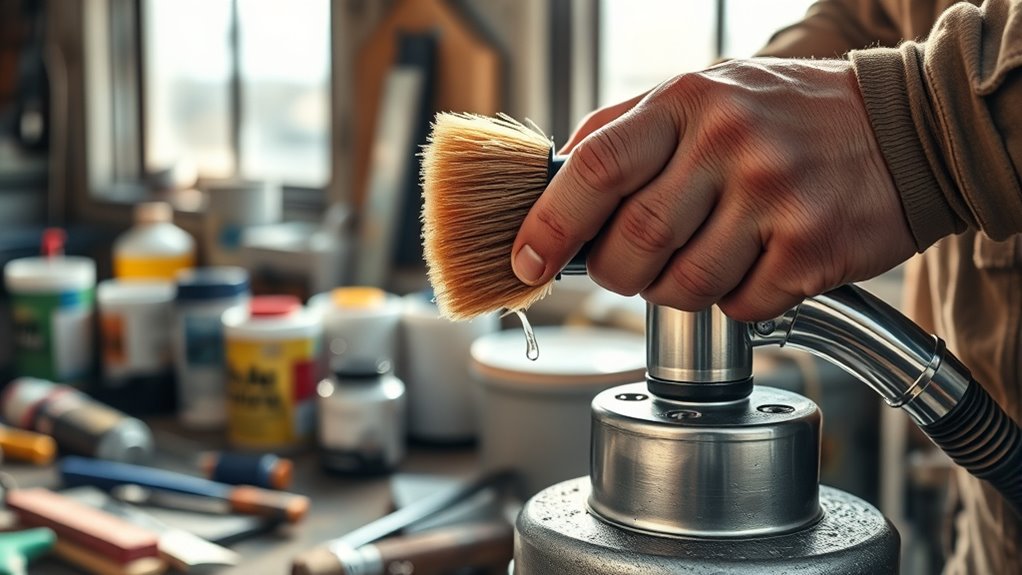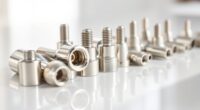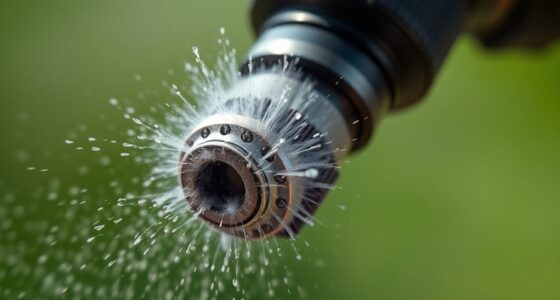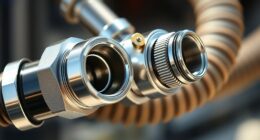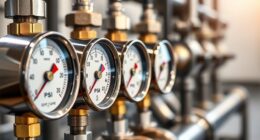To keep your sprayer job-ready, start each day with a thorough safety inspection, checking hoses, nozzles, and connections for leaks or damage. Calibrate the sprayer to the manufacturer’s specs to guarantee accurate application and prevent waste. Perform routine maintenance like cleaning filters and inspecting safety guards. Keep detailed records of these steps to stay compliant and organized. Sticking to this routine enhances safety, efficiency, and equipment longevity—discover more tips to boost your daily prep.
Key Takeaways
- Perform daily cleaning and inspection of hoses, nozzles, and connections to prevent leaks and ensure proper function.
- Calibrate the sprayer output to manufacturer specifications to maintain application accuracy.
- Check safety shields, guards, and protective gear for damage and proper use before starting work.
- Record calibration settings and safety checks to ensure compliance and facilitate troubleshooting.
- Prepare tools and safety equipment the night before to streamline the morning startup and reduce delays.

Starting your day with a clear daily maintenance routine is essential for contractors to stay organized, guarantee safety, and keep projects on track. One of the most critical steps is ensuring your sprayer is ready for the day’s work. Proper sprayer calibration is key to delivering accurate application rates and avoiding costly mistakes. Before you start spraying, take a few minutes to check and calibrate your equipment. This involves measuring the output of your sprayer and adjusting pressure or nozzle settings to match the manufacturer’s specifications. Proper calibration prevents over-application, which can waste materials and create environmental hazards, and under-application, which can compromise the quality of your work. Regular calibration also helps you stay within safety guidelines, reducing the risk of accidental overexposure to chemicals. Incorporating routine equipment maintenance can further extend the lifespan of your sprayer and improve performance throughout your projects. Alongside calibration, conducting thorough safety inspections should be a non-negotiable part of your routine. Safety inspections are your first line of defense against equipment failure or accidents. Check hoses, nozzles, and connections for leaks, cracks, or signs of wear. Make sure all safety shields and guards are in place and functioning correctly. Inspect your protective gear—gloves, masks, goggles—to ensure they’re clean and in good condition. If you spot any issues, address them immediately before starting work. This proactive approach minimizes the chance of spills, exposure, or equipment breakdowns during the day. Remember, safety inspections aren’t just about compliance; they’re about protecting yourself and your crew from preventable hazards. Integrating these steps into your daily routine keeps your sprayer in excellent condition and reduces downtime caused by equipment failure. It also ensures you’re applying materials correctly, which directly impacts the quality of your work and client satisfaction. Developing a habit of routine checks and calibration means you’re less likely to overlook small issues that could escalate into costly repairs or safety violations later. Keep detailed records of calibration settings and safety inspections—this documentation can be helpful for future troubleshooting and demonstrating compliance if needed. Finally, stay organized by preparing your tools and safety gear the night before. Having everything ready makes the morning smoother and ensures you won’t forget critical steps like calibration or safety checks. A consistent daily maintenance routine not only makes your work safer and more efficient but also builds professionalism and reliability in your services. By prioritizing sprayer calibration and safety inspections every day, you set the foundation for a successful, safe, and productive workday.
Frequently Asked Questions
How Often Should I Replace Spray Tips?
Tip replacement depends on your spray tip lifespan and how often you use your sprayer. Typically, you should inspect your spray tips daily and replace them when you notice wear, clogs, or uneven spray patterns. Regular tip replacement guarantees peak performance and prevents damage to your equipment. Keep an eye on the spray quality, and don’t wait too long—timely replacements help maintain consistent application and extend your sprayer’s life.
What Safety Precautions Are Necessary During Maintenance?
You might think maintenance isn’t risky, but safety’s always essential. Always wear personal protective equipment like gloves and goggles to prevent chemical exposure. Follow proper chemical handling procedures, ensuring sprayer components are depressurized and chemicals are safely stored. This reduces accidents and health hazards. Staying vigilant during maintenance keeps you safe and your equipment in top shape, preventing costly mistakes or injuries. Prioritize safety to work confidently and efficiently.
Can I Use Household Cleaners to Clean the Sprayer?
You shouldn’t use household cleaners to clean your sprayer because they may not be chemically compatible. These cleaners often contain ingredients that could damage or clog your equipment, leading to poor performance. Always check the chemical compatibility of cleaning agents with your sprayer’s materials. Using proper, manufacturer-recommended cleaning solutions guarantees your sprayer stays in top condition and prevents costly repairs or malfunctions.
How Do I Identify Early Signs of Equipment Wear?
If you’re attentive during equipment inspection, you can spot early signs of wear before they become major issues. Look for worn component signs like unusual noises, leaks, or decreased performance. Keep an eye on your sprayer’s moving parts and seals, as subtle changes often hint at underlying wear. Regular inspections help you catch these signs early, ensuring your equipment stays reliable and minimizing costly repairs down the line.
What Is the Ideal Storage Temperature for Sprayers?
You should store your sprayer in a controlled environment with stable storage conditions to prevent damage. The ideal storage temperature is typically between 40°F and 60°F (4°C to 15°C). Temperature control is essential because extreme heat or cold can cause parts to expand, contract, or corrode. Make sure your sprayer is clean and dry before storage, and avoid areas with high humidity or temperature fluctuations to keep it in top shape.
Conclusion
By sticking to this daily maintenance routine, you’ll keep your sprayer in top shape and guarantee every job runs smoothly. Neglecting these simple steps could turn your reliable equipment into a ticking time bomb of costly repairs. Remember, a well-maintained sprayer isn’t just a tool—it’s your secret weapon for success. Stay consistent, stay vigilant, and your equipment will perform like a racehorse, not a worn-out mule!
Franz came aboard the Paint Sprayer Zone team with a background in both journalism and home renovation. His articulate writing style, combined with a passion for DIY projects, makes him an invaluable asset. Franz has a knack for breaking down technical jargon into easy-to-understand content, ensuring that even the most novice of readers can grasp the complexities of paint sprayers.
